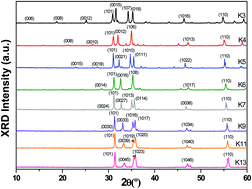Structural characterization at the atomic level and optical properties of the ZnkIn2Ok+3 (3 ≤ k ≤ 13) system†
Abstract
Several terms of the homologous series ZnkIn2Ok+3 (3 ≤ k ≤ 13) have been synthesized following solid-state reactions with an exhaustive control of the synthesis parameters. A detailed study using High Angle Annular Dark Field (HAADF) and Annular Bright Field (ABF) Scanning Transmission Electron Microscopy (STEM) was carried out, in order to investigate the structure of these materials. The [010] zone axis shows a gradual shift of the oxygen position in order to keep the polarization neutrality along the c axis and allows the formation and stabilization of the structure, while no difference in the indium distribution inside the wurtzite blocks is visualized. On the other hand, images from the [1![[1 with combining macron]](https://www.rsc.org/images/entities/char_0031_0304.gif) 0] zone axis show the characteristic zig-zag modulation of this homologous series for terms with k = 4 and 7. Electron energy loss spectroscopy (EELS) confirms the preference site of In3+ along this zig-zag pattern. Raman spectra recorded under both resonant and non-resonant conditions have been related to either vibrations of the In–O or In/Zn–O sublattices or as characteristic of the whole ZnkIn2Ok+3 structure. The frequency shift of vibration modes related to the In/ZnO sublattice is discussed in terms of phonon confinement due to the nature of these materials. Cathodoluminescence measurements reveal a main emission band centered at 1.75 eV, which shows an increase of intensity with k, which can be attributed to the existence of zinc vacancies.
0] zone axis show the characteristic zig-zag modulation of this homologous series for terms with k = 4 and 7. Electron energy loss spectroscopy (EELS) confirms the preference site of In3+ along this zig-zag pattern. Raman spectra recorded under both resonant and non-resonant conditions have been related to either vibrations of the In–O or In/Zn–O sublattices or as characteristic of the whole ZnkIn2Ok+3 structure. The frequency shift of vibration modes related to the In/ZnO sublattice is discussed in terms of phonon confinement due to the nature of these materials. Cathodoluminescence measurements reveal a main emission band centered at 1.75 eV, which shows an increase of intensity with k, which can be attributed to the existence of zinc vacancies.



 Please wait while we load your content...
Please wait while we load your content...